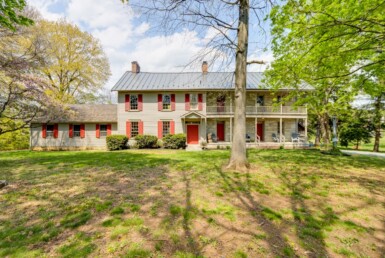ABOUT NOTLEY
Notley is a single-story, mid-century modem, ranch-style, private residence designed in 1945 by Montgomery County, Maryland architect, John A. d’Epagnier, A.I.A., that captures the American design movement by intermingling design, nature, and a communal lifestyle. The home combined elements of Frank Lloyd Wright’s prairie home style and Usonian style with influences from the Bauhaus/ International era-inspired social philosophies, contemporary architect, Richard Neutra, and Montgomery County architect, Charles M. Goodman.
Using some aspects of Usonian-style homes, the original floor plan for phases I and II mimicked the shape of a polliwog. The tail of the polliwog is represented by the bedroom wing, with each bedroom opening off into a long, narrow hallway. The hallway leads into ‘the body’ of the house, which consists of a bright and expansive living room or Great Room, alongside a kitchen and foyer. The configuration allowed for additional rooms to be added to the bedroom wing in the future.* As intended with the Usonian style, at Notley, the original polliwog shape gave way to a more U-shaped structure with the third phase, which was built off the opposite side of the long hallway and included 2 bedrooms and a bathroom with laundry area.
The frame-construction Cherokee Red-painted house with a front wall of windows, sloped, cantilevered roof, block construction foundation with walk-in half basement and crawl spaces, is situated on 4.86 acres of rolling hillside in Colesville, MD. In 1945 the land was accessible via a dirt road, R.F.D #1, which later became Notley Road.
In 2016, a modified bitumen roof, which is a mix of asphalt and rubber with a layer of gravel on top that is used for built-up roofs (BURS), was added. This type of roof is used to support a slag roof. The cantilevered overhangs offer passive solar heating and natural cooling (air conditioning was not used in the Notley home until the 21st century because there was “always a breeze on the hill,” according to Mrs. R. d’Epagnier). The long overhangs of the roof shade the heat from the summer sun as it climbs higher in the sky, creating a flow of air from the cool side to the warm side. Natural lighting was captured with clerestory windows. There are approximately 37 windows varying in style and include louvered, casement, jalousie, vented clerestory, and a window wall. Passive solar design is seen on the south side of the house that is shaped as a chevron to catch the heat of the sun as it travels the sky from morning to mid-afternoon. The large stone fireplace located in the center of the Great Room retains the heat, as does the stone flower box under the window wall. The cinderblock foundation includes the basement, which consists of a partial walk-in space with concrete floor, 2-sectioned utility tub, furnace, built-in shelving and racks, electricity, utility boxes, and 2 crawl space areas.
In the 5-bedroom (1 includes a folding partition), 3-bathroom home, the open floor plan of the house includes walls of windows and strong horizontal lines that hug the ground, broad overhanging eaves, prominent central hearth and chimney of mixed stone from local quarries and a bluestone keystone above the fire box, the outside of which is sealed with a clear stone sealer; and a brick fireplace, built-in planter, exposed beams, and built-in closets. There are 8-foot ceilings throughout the house and in the bedroom wings, with 10-foot ceilings in the Great Room (266.4 SF) and dining area (137 SF) due to the sloping cantilevered roof. Natural materials of various woods and stone were used throughout.
The house was built in 3 phases, the first 2 of which were built by Mr. d’Epagnier and masonry and carpentry subcontractors, beginning in 1946 through 1957.
In 1946-7, the first phase consisted of a 4-bay, hardwood maple-floored Great Room for dining, socializing, and originally sleeping. The details of the Great Room include a centrally placed, large floor-to-ceiling Maryland bluestone fireplace and hearth, the wall of which wraps around into the dining area and becomes a glazed brick wall on the kitchen side; checkerboard-panel walls of finely ribbed plywood in Douglas fir, three expansive bookshelves, built-in seating, a wall of glass on the west side consisting of four 8′ x 6′ double-paned insulated windows, two large casement windows with cranks on the north and south side, baseboard hot water heating, built-in stone flower box with running water, four sets of copper-capped louvered windows, a built-in china closet, and two built-in storage cabinets, a wooden bar with storage on the dining room side and separate storage on its kitchen side, and a wood-framed entryway with an open transom to the kitchen. Also, in phase one in keeping with mid-century design, a small kitchen(@ 125 SF; 8′ ceiling with exposed beams) was added and included a laundry area, furnace area, which is now in the basement, and built-in cabinetry. Additionally, in this phase, a tiled bathroom with ceramic-tile floor, built-in closet, and casement window; an outdoor storage closet, which is now a kitchen-accessible pantry; a carport, now a porch; and a pump house.
Today, the redesigned kitchen also has an eat-in nook with kidney-shaped custom-designed table with Nassau-design Formica top and banquette bench with Naugahyde upholstery; a built-in large fan housing for cross ventilation, a large, walk-in pantry, built-in cupboards, a utility closet, a small grotto-shaped wall niche with electricity, an L-shaped Formica-covered counter top with large stainless steel sink and L-shaped Pella windows above, tiled windowsills, hardwood cabinetry, a single casement window, commercial sized appliances, electric stove-top burners, double oven, built-in broom closet on tiled wall, second counter or wet bar along brick glazed wall with a second stainless steel sink, three glass shelves, two built-in storage cabinets, and a door to the porch.
The second phase, built in 1949, consisted of a reconfigured main entrance in a courtyard (originally, the main door had faced west) and a serpentine-shaped vestibule(@ 79 SF with 8′ coffered ceiling, the beams of which extend beyond the walls as a cantilever support for the long eaves) that provided access to the Great Room, kitchen, and bathroom, which were built in the first phase. The vestibule or foyer had finely ribbed plywood walls in Douglas fir, a popular motif in the 1950s; oak parquetry flooring, an oversized front door, and a center ceiling light, and two small coat closets. The second building phase also added a doorway from the foyer, hardwood white oak flooring to the long hallway (82.5 SF), the tail of the polliwog shape, with an exposed-beam ceiling, ceiling-line clerestory venting windows facing the courtyard, and a partially recessed wall; one large, southwest-facing Children’s Room, later partitioned to become two bedrooms (140, and 147 SF, respectively), each with solid white oak flooring, exposed-beam ceilings, large louvered windows with sidelight windows on either side, converted baseboard hot water heating, two closets (30 SF and 10 SF, respectively), one with access to HV AC unit return; and a wood-paneled master bedroom (168.6 SF). The master bedroom includes a brick fireplace with stone mantel and raised hearth with a chimney with a full 2″ mortar cap, not sealed; built-in shelving and storage cabinet, large louvered window with sidelight windows on either side, closet with electrical lighting, converted baseboard hot water heating, and a ceramic-tiled bathroom with shower, window and built-in storage cabinet.
The re-positioned front entrance faced northeast and was nestled in a courtyard, another feature of the Usonian homes; namely, to not have the main entrance be on the public side. The main entrance no longer faced Notley Road. A main entranceway was added with an oversized wooden front door with double-paned side light windows and air vents on either side. Today, a flagstone walkway leads to the front door with a flagstone landing to the portico with a self-designed ornamental ironwork and flagstone-topped stone planter boxes on either side of the main entrance. A landscaped, courtyard(@ 480 SF) surrounded by a stone wall with an old, large, berrybearing holly tree, azalea, and rhododendron bushes goes from the top of the driveway to the front entrance.
The third phase, built in 1957, added two bedrooms (169 SF and 162 SF, respectively) with solid white-oak flooring, exposed-beam ceiling, and large walk-in closets (25 SF and 26 SF, respectively), built-in bookcases, a ribbon of clerestory windows and a partial recessed wall, built-in lighting, three built-in bookshelves, and a large walk-in closet in one bedroom; additionally, the other bedroom has large L-shaped Pella windows, one large walk-in closet and one smaller closet with access to plumbing for shower; access to plumbing for laundry is behind framed-out doors. A bathroom with shower, built-in storage, a tiled laundry area with built-in cabinetry and another full-length built-in closet were added. This phase also included converting the carport to a three-sided screen and stone porch with flagstone floor and half stone wall with wooden, vertically louvers on the wall on the west side. Electrical outlets are included. The porch leads outside to a flagstone ramp surrounded by stone walls and a lamppost. The original W-shaped support beams of the carport, another Frank Lloyd Wright influence, remain.
A long, paved, circular partially-fenced asphalt driveway on the north side of the property with parking at the top for multiple cars ascends the first hillside on the property and veers in a southerly direction to the top, where there is access to the house. The driveway loops around a circle of sugar maple trees separated from boxwoods by a free-standing stone wall.
In 1945, the property had a 50+-tree apple orchard, 10 peach trees, and a small cinderblock storage structure. The structure (@240 SF) remains at the back of the property today. Added to it in the mid 1980s is a two-level wood plank–sided storage barn(@ 720 SF-l51 level; 384 SF-2nd level) with a cinderblock and concrete foundation, dirt floor for the first story, and a shingled “teepee”-style roof and plywood floor on the second story, which is accessible via a railed wooden ramp.
On the property also and built in the first phase is a hip-style, slate-roofed cinderblock construction pump house(@ 81 SF) with a redbrick topped wall in a concrete-floored drainage area. It also has a louvered, wooden vertical screen on its northern side, which is similar to the wooden louvers on the western side of the porch. It contains a water conditioner system, reserve tank, shelving for garden tools, electrical outlets, and an outside spigot.
Additionally, in the early 1970s a two-sectioned workshop/studio (@594 SF) of frame construction with a pitched tin roof, centeropening barn doors, wooden floors, six windows, electricity, a standard door, a wood-burning stove, built-in shelving and tool benches were added as was a greenhouse(@ 63 SF) with electricity, dirt floor, workbench, shelving, and plumbing; and a paved, fully fenced, regulation-size tennis court.
*https://en.m.wikipedia.org/wiki/Gerald _ B. _and_ Beverley_ Tonk ens_ House.



